THE first military
Governor appointed to Newfoundland was Major (afterwards
Lieutenant-General) Sir John Harvey, in 1841; he was also the first
Governor who had a private secretary. Sir John Gaspard Le Marchant
assumed the Government in 1847, and also brought with him a private
secretary. The Governor of Newfoundland is not Lieutenant-Governor, like
the Governors of Nova Scotia, New Brunswick, and Prince Edward Island.
The only authority to which he is subordinate is the Queen aud her
Ministers. The following amount of salaries was at that time paid out of
the revenue ol the Colony:—
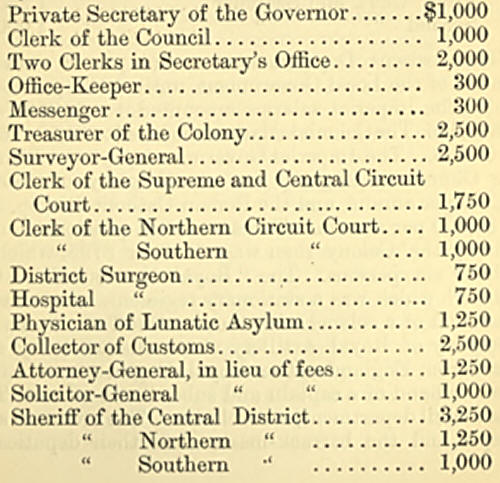
The following salaries
were paid out of the Colonial Revenue under Acts 2nd and 3rd William
IV., cap. 78, called the reserved salaries.
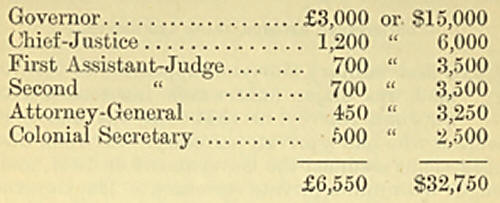
The post-master was
paid $1,000 by the Imperial Department, which also paid the following
officers of Customs who were still retained :—
Comptroller of Customs
and Navigation Laws............................ $1,500
First Clerk and Searcher............ 1,250
Second “ “ . ........... 1,000
The Customs Department
was not placed under the control of the Local Government until 1849,
previous to which the Imperial salaries amounted to £3,703 7s. 7d., or
$78,516. The Colonial salaries amounted to £1,864 16s. 5d., or $9,323.
The Imperial Government pays the Bishop of the Church of England an
annual salary of £500, or $2,500 per annum, and the Roman Catholic
Bishop, £300, or $1,500 per annum. The amount of pensions annually paid
by the Colony then was £159, or $795, which was paid to six persons. The
“ Royal Newfoundland Companies,” which was a stationary regiment, was
under the command of a colonel with the usual staff of officers. The
Company of Royal Artillery were relieved every seven years from England.
The Royal Engineers were under the command of a captain and subordinate
officers. There was a civil department, with clerks. The ordnance
storekeeper and the barrack-master had their deputies and clerks.* The
naval establishment has for a long time been removed from Newfoundland
to Halifax and Bermuda. One or two men-of-war are usually on the station
for the protection of the fisheries. There is no militia in
Newfoundland, but there are two volunteer companies. The war
establishment in Newfoundland costs Great Britain over $200,000
annually. The Chief-Justice was also Judge of the Vice-Admiralty Court,
which made his salary considerably more. The fees of the
Attorney-General were very small, and the Legislature thought proper to
allow him $1,250 per annum in lieu of these fees, making his salary
$3,500 per annum. The fees of the Solicitor-General were about $200 per
annum, in lieu of which the House of Assembly voted him a salary of
$1,000, besides which he received $500 a year as Master-in-Chancery, the
dutiesof which were merely to take a fewmessages from the Council to the
Assembly, accompanied with two or three bows. The salary of the
Surveyor-General was raised from $1,500 to $2,500, besides the
allowances. The office of Private Secretary to the Governor was
attempted to be abolished when the term of the then Governor expired,
but it is still retained. In addition to his salary of $2,500, the
Secretary of the Colony in 1854 received as Clerk of the Council $1,000,
and a further sum of about $500 for receiving the amount of sales of
Crown Lands, &c., making his salary altogether upwards of $4,000 per
annum. The Treasurer of the Colony, in addition to his salary of $2,500
received $500 more as Cashier of the Savings’ Bank. It had long been the
practice to exact for every commission issued from the Secretary’s
office from one to five guineas. The writer paid one guinea for the
first commission he received. For the second he was asked five guineas
but refused to submit to so unjust a tax, the commission was, however,
given. The Collector of Customs received, in addition to his salary,
$1,000 as All the military have been withdrawn from the Colony.
Speaker of the House of
Assembly. Previous to the year 1847 the salary of the Sheriff of the
Northern District, averaged from 200 to 350 dollars per annum, whilst
the salary of the Sheriff of the Central District was nearly $4,500 per
annum—the disproportion. The salary of the Sheriff of the Central
District, for a population of 25,000, now receives $3,250, while the
Sheriff for the Northern District, for a population of 50,700, receives
$1,250, and the Sheriff of the Southern District, for a population of
about 10,000, receives $1,000. There should be a sheriff for every
district. 1 know of no colony or country in America without a sheriff
for every county or district except Newfoundland.
The salary of the Clerk
of the Southern County Court some years ago was $500; it was afterwards
raised to $1,000 per annum. The duty of the otiice was to attend the
judge on circuit once a year, which occupied nearly two months. The
remaining ten months of the year the clerk remained in a remote and
almost inaccessible part the district; until within the last two years
(owing to the want of roads). The colony annually paid $5,750 per annum
for the hire of two vessels to take the Court on circuit, in addition to
which a saloon was fitted up and a well-supplied table of the edible and
potable. The sitting of the Court in some places was a mere mockery, and
in other places it did not sit at all, although it would have been
previously announced to do so by the Governor’s proclamation. This state
of things strongly reminds one of the good old days of the Fishery
Admirals and Floating Surrogates. In 1847, the acting Judge refused to
take a prisoner from Harbour Breton to Burin Gaol, because it would
lessen the dignity of the Court by making the ship a prison, in
consequence of which the following expedient was adopted to get rid of
the prisoner: A fishing boat was bound to Hermitage JBay, on board of
which he was put, the master of the boat receiving strict injunctions to
conceal from the prisoner the place of destination, but, as soon as they
arrived at Hermitage Bay, to tell the prisoner to make off as fast as
possible. There ought to be District Judges, as there are in Canada. One
of the clerks in the Secretary’s office, in addition to his salary of
$1,000, received $1,000 more as Clerk of the Legislative Council, and an
additional sum as Marshall of the Court of Vice-Admiralty. The other
clerk of the Secretary’s office received a further addition to his
salary as clerk of the Building Committee, &c. Of all the foregoing
offices, there are but four filled by natives of the colony, one of whom
was appointed Treasurer of the Colony in 1849.
It was exceedingly
trying to the minds of respectable, intelligent natives to see men from
afar filling offices under the Government of their own country, and
receiving large salaries, which they would be glad to fill as
efficiently for half the amounts the incumbents were receiving.
The following is an
extract from the editorial of one of the Conception Bay Heralds (1853):—
“None but vagabonds are
encouraged in Newfoundland. The selfish, unscrupulous pretender is just
the sort of plant that thrives best in our soil The man who, in addition
to an incorrigible stupidity, can bring his conscience to acquiese in
anything touching his own gain, or that of his own patron, is what we
want here. Are there any such in the adjacent Provinces? Let them come
hither, and we will ensure them success. Nay, have not many of them come
hither already and reaped their harvest 1 Let the public answer.”
Since that time, and
consequently since the introduction of Responsible Government, some of
the highest offices in the Government are filled by Newfoundlanders (a
number of stipendiary magistrates, Custom-house officers, and numerous
others), so that now Newfoundlanders have no cause to complain that they
are left in the cold shades.
On the introduction of
Responsible Government, in 1855, the salary of the Governor of
Newfoundland was reduced from $15,000 to $10,000 per annum (it is now
$12,500). There was also a reduction made in the salaries of all the
other Departments. The following are the salaries of the other
North-American colonies :—
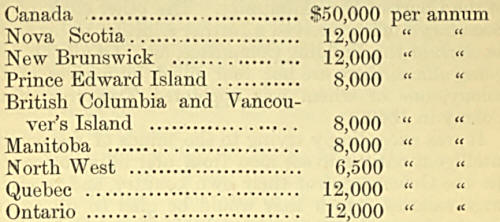
The salaries of the
officials of the Government of Newfoundland were paid in sterling
money—or nearly five dollars in the pound.
Before the introduction
of the Responsible Government of Newfoundland, the Council consisted of
nine members, who were appointed by the Crown, who were both Executive
and Legislative ; all the members of which belonged to St. Johns. Of
these, five were merchants, one a barrister, and the remainder officials
of the Government. Five were Episcopalians, one Roman Catholic, two
Congregationalist, and one Presbyterian. Six were Englishmen, one
Irishman, one Scotchman, and one Nova Scotian.
The House of Assembly
sat quadrennially. It was composed of fifteen members :
Three for the district
of St. John’s.
Four “ “ Conception Bay.
One “ “ Trinity Bay.
One “ “ Bonavista Bay.
One “ “ Fogo.
One “ “ Ferryland.
Two for the district of Placentia and St. Mary's.
One “ “ Burin.
One “ “ Fortune Bay,
Having the following
occupations:—Merchants, 4; trades, 3 ; lawyers, 3; editors, 2 ; doctors,
1; lieutenant, R.N., 1 ; surveyor of roads, 1. Eight were Roman
Catholics, five were Episcopalians, and two Congregationalists. Six were
natives, three Irish, three English, one native of Prince Edward Island,
one of the Island of Jersey, and one Nova Scotian.
The following were some
of the annual expenses of the Legislature at that time :—
Legislative Council

House of Assembly
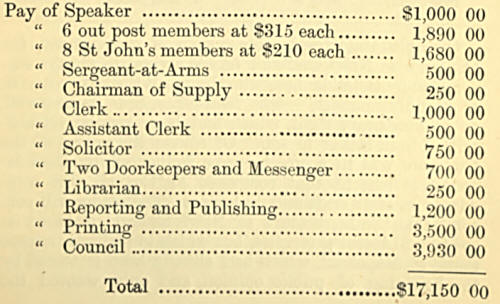
The following is the
length of Session of the General Assembly:—
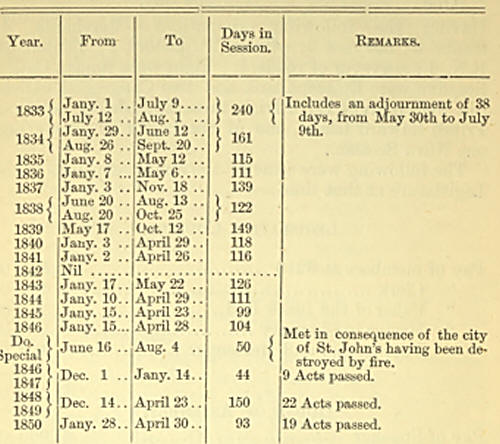
Owing to the
irresponsible system of government, the Governor of Newfoundland, on his
arrival, is always surrounded by the same men who composed the little
coterrie, or “family compact,”—who held office, time immemorial, as an
hereditary right, which had been regularly transmitted from father to
son. Of course the policy of the Governor was in a great degree
influenced by the irresponsible persons that composed his Council, who
were adepts in state craft and diplomacy. The reader will perceive that
the Legislature of Newfoundland is based on professed Liberal
principles, but which in reality is a little castle of despotism, which
had already been scattered by the lightning of public opinion, and only
wanted the thunder of a free press, to make it totter, fall, and become
a ruin.
What is called
“Responsible Government,” had been conceded by the Home Government to
the neighbouring British Colonies. This system of Government is composed
of two district Councils, an Elective and Legislative, and all heads of
Departments are appointed from the majority of the political party of
the Representatives of the people, from whom also the Executive Council
is selected.
Every Government ought
to be the mere exercise and reflection of the public mind, [and the
public will. The people should be the father, the government the child.
During the last Session
of the amalgamated Legislature in 1847, Mr. Kent, a leading member of
the House, introduced a series of resolutions, embodying the principles
of Responsible Government, which passed the Legislature by a majority of
one vote. Subsequently a petition was sent to the Home Government,
praying that the same privileges of Responsibility as had been given to
the neighbouring colonies, may be conceded to Newfoundland. But Earl
Grey, the then Secretary of State, thought it inexpedient for the
present, so far as Newfoundland was concerned, to test the truth of the
political axiom, that “ Freedom is the only certain cure for the evils
of Freedom.”
In order to carry out
the system of Responsible Government in Newfoundland, an increase of
Representation was absolutely necessary. In the first Legislature in
1834, Mr. Kough introduced a Bill to increase the Representation to 25
members, which, however, did not pass. In 1844, the late Mr. Barnes, one
of the most talented natives of the country, brought in a Bill, which
contemplated a division of the Districts, as well as an increase of
Representatives. This Bill met with a most determined opposition from
the Roman Catholic members of the House, because it divided the Roman
Catholic districts, and very justly apportioned members according to
population, instead of extent of territory. In all countries
Representatives are given according to 'population, not extent of
territory, and the reader will see the justice of Mr. Barnes’s division
of the Districts, by observing that Placentia and St. Mary’s for a
population of 6,471, returned two members, while the District of
Trinity, with a population of 8,801, returned only one member.
It is said Mr. Barnes
had a majority to carry his Bill through the House, but consented to
withdraw it on the promise of Sir John Harvey, the Governor, that the
Bill should form the basis of the new Constitution of Newfoundland,
which would take place at the termination of the amalgamated
Legislature. The promise, however, was not fulfilled. A Bill was brought
before the House of Assembly in 1852, for the increase of
Representatives to 25 members, leaving the divisions and districts as at
present. After some time, an Act passed, making the number of members of
the Assembly 30, and the Legislative Council 12, with an Executive
Council of 7. The following are now the divisions of the districts :—
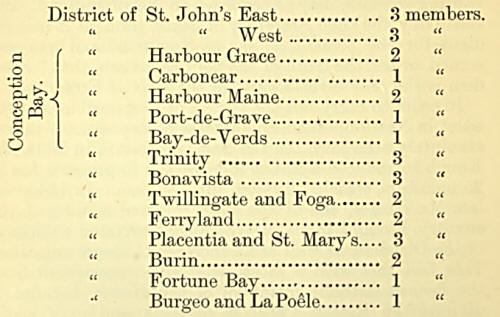
The terms of Whig and
Tory, are scarcely applicable to Newfoundland. The struggle has always
been between the Roman Catholics and Protestants. The former voting for
the Roman Catholic candidate, and the latter, with but few exceptions,
voting for the Protestant candidate. The Protestants are called
Conservatives, and the Roman Catholics, Liberals. The introduction of
Responsible Government met with great opposition. The old oligarchy were
very tenacious of life, hence their cries of “ innovation ’’— old paths
well enough—departed glory—and “Ichabod.” But these hostile
demonstrations to the march of enlightened public opinion, were but the
spasmodic death-throes that precede expiring life.
Responsible Government
is nothing more or less than the principles of the British Constitution,
referring to which, the celebrated statesman, Fox, said:
“The greatest
innovation that could be introduced into the Constitution of England was
to come to a vote that there should be no innovation in it. The greatest
beauty of the Constitution was that in its very principle it admitted of
perpetual improvement, which time and circumstances rendered necessary.
It was a constitution the chief excellence of which was that of
admitting a perpetual reform/’
The Protestants were
opposed to Responsible Government, on the ground that Roman Catholics
would monopolize all the offices of trust and emolument. But this was
impossible, if the Protestant voters did their duty, there being a
majority of 10,000 Protestant votes in the districts. It was not until
the arrival of Governor Darling, in 1855, that the system of Responsible
Government was fully inaugurated, when the Hon. John Kent became the
Premier, and Philip F. Lyttle, Esq., Attorney-General.
Although Newfoundland
is not at present a portion of the Dominion of Canada, yet we hope, at
no very distant day, to see this, the only unconfederate British
possession in North America, united to Canada. Her amalgamation would
develop her great resources, especially her minerals and fisheries.
Lines of steamers for the conveyance of goods and passengers would run
from Quebec to St. Johns, calling at the intermediate ports of St.
George’s Bay, Bay of Islands, &c. New life would be diffused into the
various fisheries, and agriculture and manufacture would receive a fresh
impetus. The principal objection to confederation is the erroneous
notion to make no change, to keep things fixed just as they are. Dr.
Arnold says :—
“There is nothing so
revolutionary, because there is nothing so unnatural, and so convulsive
to society, as the strain to keep things fixed, when all the world is,
by the very law of its creation, in eternal progress. And the cause of
all the evils in the world may be traced to that natural, but most
deadly, error of human indolence and corruption—that our business is to
preserve, not improve. It is the ruin of all alike, individuals,
schools, and nations.”
The following are the
Governors of Newfoundland from the earliest period :—
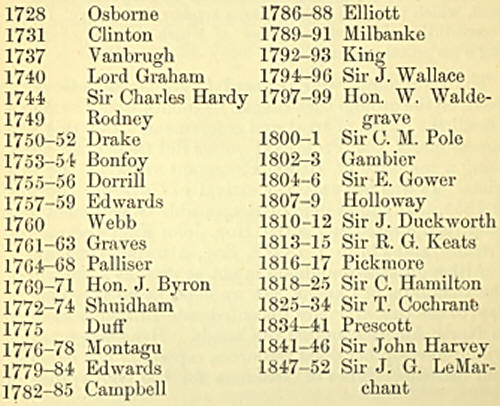

In Newfoundland there
is no direct taxation, the revenue is principally derived, from duties
on imported goods. The following is the Newfoundland Tariff, 1870 :—
“ According to Revenue
Act passed 1875 :
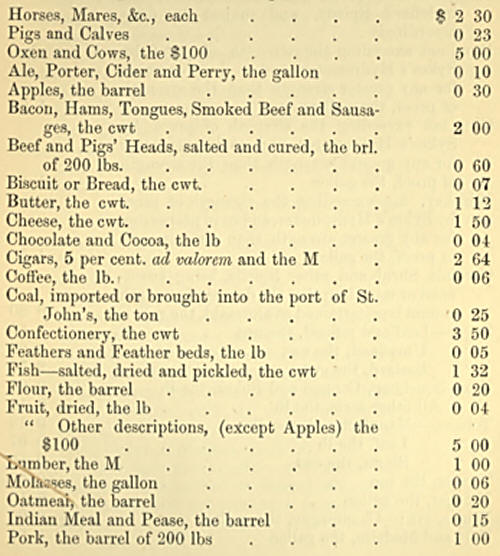
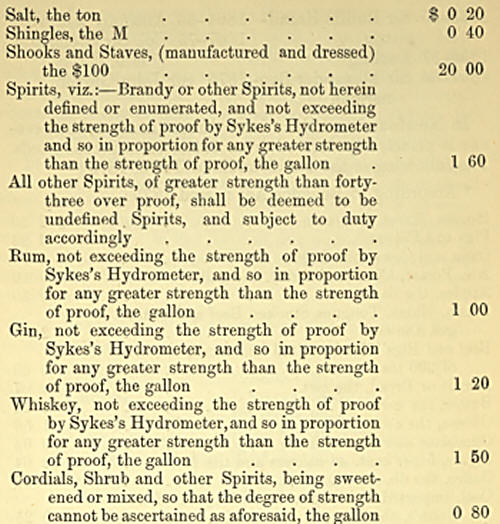
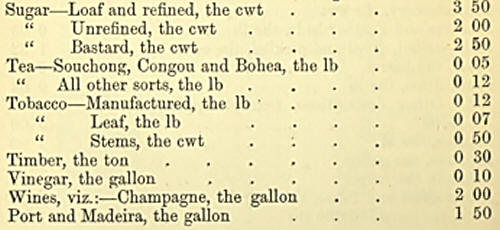
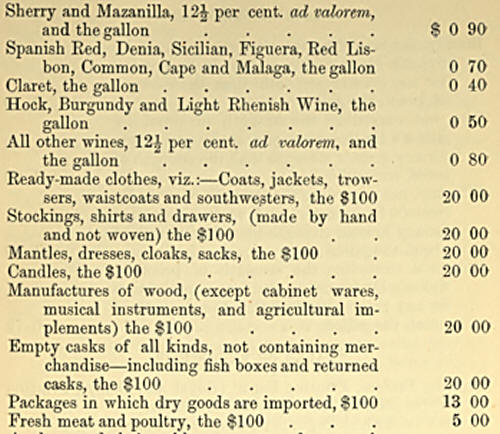
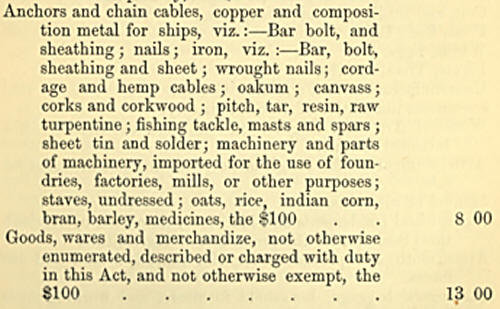
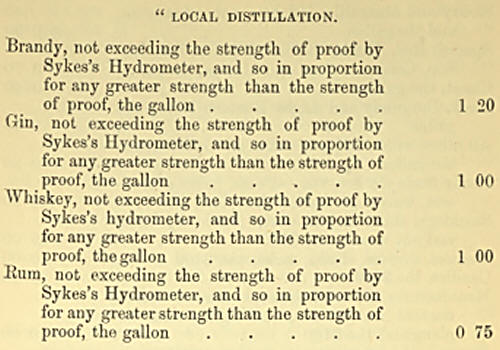
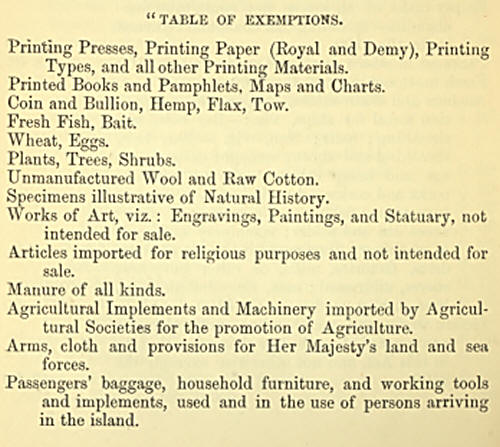
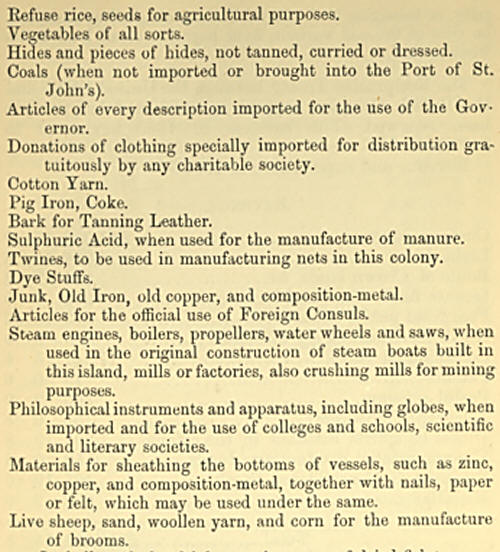
“It shall not be lawful
for any importer of dried fish to warehouse the same in any of the ports
of this colony or its dependencies, without the payment of the duty
hereinbefore imposed; and the provisions of any Act of this colony with
regard to the warehousing of goods on the first entry thereof, or to the
allowance of drawbacks upon exportation, shall not in either case apply
to or be construed to apply to such fish. Provided, that the section
shall not apply to such fish of British catch and cure, unless otherwise
declared by proclamation of the Governor, published in the Royal
Gazette.
“All yachts sailing
under warrant of the Lords of the Admiralty, or belonging to the Royal
Yacht Club, shall be exempted, on view of the said warrant, from payment
of all local duties whatsoever.”
The Reciprocity Treaty
between the United States and the British Colonies expired in 1865, and
has not yet been renewed. The revenue in 1853 amounted to $400,000.
Revenue and expenditure
in 1856:—
Revenue
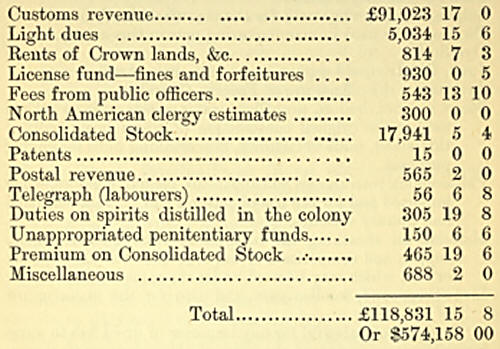
Expenditure

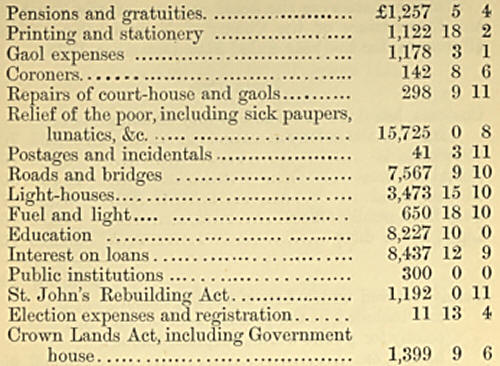
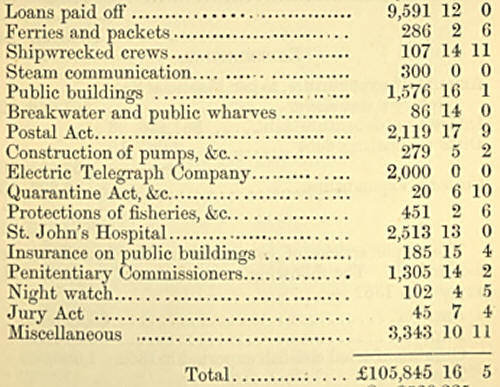
There was a Branch Bank
of British North America established in St. John’s for about seventeen
years. The first draft of this Bank was drawn on London, December 14th,
1836. It was closed in 1853, and the building occupied as a Bank was
purchased by the Commercial Banking Company of Newfoundland. There is
now, besides the Savings’ Bank, the Commercial Bank and the Union Bank.
These, with a branch of the Savings’ Bank established at Harbour Grace,
in Conception Bay, are the only banking establishments in Newfoundland.
There are twenty-six
light-houses on the coast of Newfoundland, besides the light-houses on
the French island of St. Pierre. The following is a description of the
lights:—
“ St. John's.—Two red
lights are exhibited, intended as leading marks for vessels entering the
narrows.
“ Fort Amherst.—This is
a stationary light, on the southern head of the entrance of St. John’s
harbour, first established in 1813.
“ Cape Spear.—This is a
powerful revolving light, burning at an elevation of 275 feet above the
level of the sea, and showing a brilliant flash at intervals of one
minute. In clear weather it may be seen from sea, in any direction, at
the distance of thirty-five miles.
“ Harbour Grace.—This
is a powerful fixed light, situate on Harbour Grace Island, in
Conception Bay, extending easterly or seaward, in a direction by compass
from north to south-west.
“ Bonavista.—This light
revolves every two minutes, showing a red and white flash alternately;
and it is elevated 150 feet above the level of the sea.
“ St. Peter's.—A light
house has been erected by the French Government on Galantry Head, near
Cape Noir. The light is a fixed one. It burns at an elevation of about
210 feet above the level of the sea. It may be seen (in passing from N.
N. W. to N. N. E.) at the distance of eighteen or twenty miles, in clear
weather. In passing by the north it is shut in by high land from N. N.
E. to W. N. W.
“ Ferryland Head
Light.—First exhibited on the 1st October, 1871. From sunset to sunrise,
a steady white light of the 3rd order, burning on a brick tower 200 feet
above the level of the sea, visible in favourable weather sixteen
nautical miles. It is situated in lat. 47° 00' 58" N, and long. 52° 51'
07" W. The tower is of red brick ; the keeper’s dwelling, detached from
the tower, is painted white and the roof red.
“ Cape Pine.—This
light-house was erected by the British Government. The building is of
iron. It is situated 246 feet above the sea, and the light is 74 feet
from the ground, making it in all 320 feet above the level of the sea.
The contractor was A. Gordon, Esq., Civil Engineer, Greenock. The
building and light are similar to that erected by the same gentleman on
the south-eastern end of the Bermuda Islands, and which is said to be
one of the finest in the world. The following are the light dues:—One
shilling per ton on all vessels entering any port or harbour of the
colony, except coasting and sealing vessels; but not to be levied more
than once in any one year. Six pence per ton on registered vessels of
forty tons and up: wards. Under forty tons, fifteen shillings per annum,
or three dollars. No greater sum than £25 sterling is to be levied in
any one year for light dues on any one steamer or vessel entering any
port in the colony; and no steamer plying between Europe and North
America, and entering any port of the colony, as a port of call, to be
liable to pay any light dues, or other port charges, except pilotage.
“ Harbour Grace Beacon
Light,—This is a harbour light, placed on the Point of Beach, at the
entrance to Harbour Grace.
“ Green Island Light,
at the entrance of Catalina Harbour, Trinity Bay. Situate in lat 48° 30'
16" N., Ion. 53’ 2' 4" \V. This is a fixed white light, burns at an
elevation of 92 feet above high water, and in favourable weather will be
seen E. N. E. seaward, to S. W., IT) nautical miles. Vessels bound
northward, by keeping this light open with the north head of Catalina,
until Bonavista light opens with Cape St. Jean, will give the Flower
Rocks an ample berth; or, when coming from the northward and bound for
Catalina, by giving the N. Head a moderate berth, you will clear the
Brandies Rocks by steering for Green Island Light. It was first
exhibited in 1857.
“Gape Race exhibits a
revolving white light From sunset to sunrise the light is visible to
seaward, from X. E. by E. round by the S. E. and S. to W. The light is
elevated 180 feet above the mean w ater level of the sea, and may be
seen in clear weather 19 nautical miles from a ship’s deck. The tower is
striped red and white, vertically. It stands close to the old beacon,
which has been cut down. The lighthouse is in lat. 46° 39' 30" N.. Ion.
53° 4' 30" W., and was first exhibited in 1856.
“ Gape Race Steam Fog
Alarm.—A powerful steam whistle has been placed on Cape I Lace, about
520 feet south of the lighthouse, which is sounded during thick or foggy
weather, or snow storms, for ten seconds, with intervals of silence of
fifty seconds in each minute. The whistle will probably be heard in calm
weather, 20 miles ; with the wind, 30 miies^: and in stormy weather,
against tlie wind, from seven to ten miles.
“ Doddinghead, Great
Burin Island, Light.—This light was put in requisition on the 3rd
August, 1858, and is exhibited every night from sunset to sunrise. It is
revolving cato-dioptric of the second order, producing a brilliant white
light every minute, burning at an elevation of 430 feet above the level
of the sea, and in favourable weather can be seen 20 miles. Situ ated in
47° 0' 26" north lat., 55° 8' 43" west Ion.
“ 1872—Puffin Island,
Greenspond.—The light-house on this island is built of granite, with the
tower and keeper’s dwelling attached. The illuminating apparatus is
dioptric of the 4th order, and a fixed red light is exhibited from
sunset to sunrise. It is 85 feet above the level of the sea, and in
clear weather should be seen a distance of 12 miles. The light is
visible from N. by E. through S. to W. by N. by compass, and is situated
in 49° 3' 37" N. lat., and 58° 32' 27" W. Ion.
“ No. I, 1873—Belloram
Fortune Bay.—A fixed white light is exhibited nightly at this place from
sunset to sunrise, at an elevation of 35 feet above the level of the
sea, and in clear weather should be visible seven miles. The building is
a wooden tower, painted white, and is situated in lat. 47° 29' N., and
55° 27' 15" W. Ion. The apparatus is dioptric of the 8th order, with a
single argand burner, and illuminates an arc of the horizon of 270°. In
entering the harbour the light must be kept on the port hand.
“ No. 2, 1873—Rose
Blanche Point.—This light-house is built of granite, up on the eastern
head. The tower and keeper’s dwelling are attached. The illuminating
apparatus is dioptric of the 4th order, and a fixed white light is
exhibited from sunset to sunrise, at an elevation of 95 feet above the
level of the sea, and should be seen in clear weather 13 miles. Shag
Island, Black Rock, bears west from the light, and distant about one
mile ; Rose Blanche shoals, W. S. W., half a mile; and Petite Black
Rock, E. by S., 3 miles.
“ No. 3, 1873—Fort
Point, Trinity.—A fixed light is exhibited nightly, from sunset to
sunrise, upon a wooden tower, painted white, and at a height of 75 feet
above the level of the sea, and should be visible in clear weather for
11 miles. The erection is situated in 48" 21' 55" N. lat., and 53" 20'
51" W. Ion. The apparatus is dioptric of the 8th order, with a single
argand burner, and illuminates an arc of the horizon of 320.° In
entering the harbour the light must be kept on the port hand.
“ Offer Wadham Island
Light.—Was first exhibited on the 4th October, 1858, and is lighted
every night from sunset to sunrise. The light is a steady, fixed
lens-light, burning on a circular brick tower, 100 feet above the level
of the sea, and can be seen in a favourable state of the atmosphere 15
nautical miles. Situated in latitude 49’ 36' 0" North longitude 53° 45'
6" West.
“ Baccalieu Island
Light.—This light is exhibited every night from the going away of
daylight ir. the evening to the return of daylight in the morning. The
light-liouse situated on the northern end of the island—latitude 48° 8'
51" North ; longitude 52° 47' 50" West—the tower is of brick, the
keeper’s dwelling (a square building detached from the tower) is painted
white, with the roof red.
“ The hght is
cato-dioptrie, first-class holophotal revolving white light, showing a
flash every twenty seconds. It is elevated 443 feet above high water,
and can be seen in clear weather 30 nautical miles, and a lesser
distance according to the state of the atmosphere. When the southern end
of the island bears N.N.E., the light will not be visible when nearer
the island than 8 miles. It was first exhibited in 1858.
“ Cape St. Marys
Light—Was put into requisition on the 20th September, 1860 ; it is a
revolving cato-dioptric light of the first order, producing alternately
every minute a brilliant red and a white light, burning at an elevation
of 300 feet above the level of the sea, and will be seen in a favourable
state of the atmosphere 26 nautical miles from the vessel’s deck;
situated in 16° 40' 30" N. lat., 54° 11' 34" W. long. The tower is of
brick, and on each side of which stands the dwelling of the keeper and
assistant, the sides of vrhich are painted white, roofs red.
“ Brunet Island Light,
Mercer’s Head, Fortune Bay.—First exhibited 27th June, 1865. It is a
powerful flashing white light, and attains its greatest bri'liancy every
ten seconds. It burns at an elevation of 408 feet above the level of the
sea, and in clear weather may be seen at a distance of 35 miles, and be
visible in every direction from North, round East and South, to W.N.W.
Mercer’s Head is a bold headland, and situated in long. 55° 59' 30" W.,
and lat. 47° 16' N.
“ No. 1, 1874. Cann
Island, Seldom-come-by.— A fixed white light is exhibited nightly at
this place, from sunset to sunrise, at an elevation of 85 feet above the
level of the sea, and should be visible 12 miles. The tower and dwelling
are of wood and attached, and are situated in latitude 49° 35' 05" N.,
and longi tude 54° 10' 33" W. The apparatus is dioptric, of the 8th
order, with a single argand burner, and illuminates an arc of the
horizon of 327°.
“ No. 2, 1874. Boar
Island, Burgeo.—A fixed red light is exhibited nightly at this place,
from sunset to sunrise, at an elevation of 240 feet above the sea, and
should be visible seventeen miles. The tower and dwelling are of wood,
and attached, and are situated in latitude 47° 36' 12" N., and longitude
57° 35' 13" W. The apparatus is dioptric of the sixth order, with a
single argand burner, and illuminates the whole of the horizon of 270°.
“ No. 1, 1875. Channel
Head, Port-aux-Basques.—A wooden light tower has been erected on this
head, and on and after this date a fixed red light will be exhibited
thereon, at an elevation of ninety feet above the level of the sea. Lat
47° 33' 47" N., and long. 50° 07' 10" West. In clear weather the light
should be visible twelve miles. The illuminating apparatus is dioptric,
of the eighth order, with a single argand burner. The whole horizon is
illuminated.
“ Rocky Point, Harbowr
Breton, Fortune Bay—situated in latitude 47p 27' 30" N., longitude 55°
47' 45" W. A square wooden tower carrying an octagon and lantern, in
which a white light will be exhibited nightly, with a red light to mark
the Harbour Rock.
“ Garnish, Fortune
Bay.—A beacon tower of wood, carrying an octagon and lantern, in which a
red light is exhibited nightly. Latitude 47° 14" N-, longitude 55° 24' W
(approximate).
“ Beacon, Ireland Eye,
entrance of La Potte Bay.—A square building of wood, painted white, with
three black bands, has been erected on this island. It is seventy-five
feet high, and is supported on four chains.
“A light-house has been
erected by the Government of Canada on the western side of Cape Ray, on
the south-west coast of the Island of Newfoundland. Latitude 47° 37' N.,
longitude 59° 18' W. A powerful flash white light is exhibited, making a
complete revolution in two and a quarter minutes, and flashing every ten
seconds : at a long distance, however, it has the appearance of a steady
light. The light can probably be seen at a distance of twenty miles in
clear weather.
“The tower is a wooden
building, hexagonal in shape, forty-one feet high, and painted white.
The keepers dwelling, also of wood, stands at a little distance from the
tower, and is also painted white. * _
“The illuminating
apparatus is catoptric, and consists of twelve lamps and reflectors.
"A fog whistle is in
operation at Cape Ray. It will be blown in thick and foggy weather, and
during snow storms, for ten seconds in each minute, leaving an interval
of fifty seconds between each blast. It can be heard from three to
fifteen miles.
